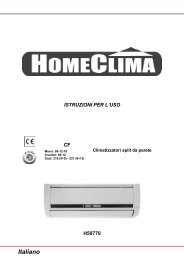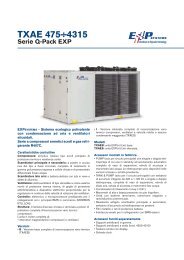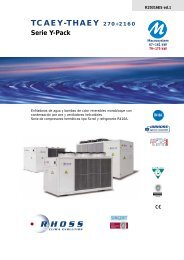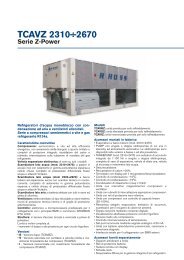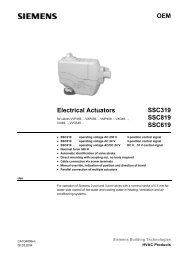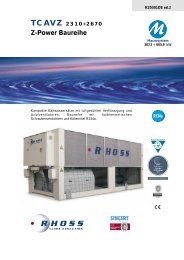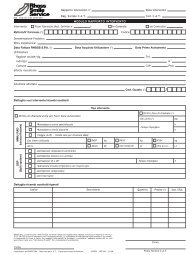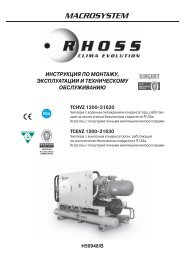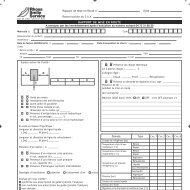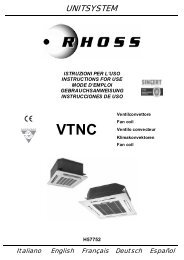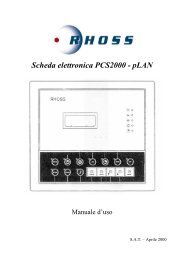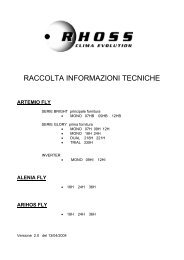tcaes 230÷4160 thae - Rhoss
tcaes 230÷4160 thae - Rhoss
tcaes 230÷4160 thae - Rhoss
Create successful ePaper yourself
Turn your PDF publications into a flip-book with our unique Google optimized e-Paper software.
SECTION II: INSTALLATION AND MAINTENANCE<br />
II.1.11<br />
STORAGE CONDITIONS<br />
The units are wrapped in a shrink-wrap nylon sheath which guarantees<br />
protection when the unit is stored in sheltered areas where it is not<br />
exposed to frequent changes in temperature. If the appliance has to be<br />
stored outdoors, remove the shrink-wrap nylon sheath to avoid the<br />
formation of condensate. If the unit is exposed to sunlight, peel off the<br />
protective film on the panelling.<br />
II.2 INSTALLING THE UNIT<br />
DANGER!<br />
Installation may only be carried out by skilled<br />
technicians, qualified to work with conditioning and<br />
cooling products.<br />
Installation personnel must comply with all<br />
applicable local or national legislation in effect<br />
when the appliance is commissioned.<br />
DANGER<br />
The corners of the unit and the finned surface of the<br />
banks may cause injury if the due care and<br />
attention is not paid during installation.<br />
II.2.1 CLEARANCES<br />
IMPORTANT!<br />
The unit must be positioned in compliance with the<br />
minimum recommended clearances and bearing in<br />
mind access to water and electrical connections.<br />
Failure to observe the recommended clearances during installation will<br />
prevent the unit from running efficiently, causing an increase in the<br />
power input and a considerable drop in the cooling power due to an<br />
increase in condensing pressure.<br />
The area above the unit must be free of any obstacles. If the unit is<br />
completely surrounded by walls, the indicated distances still apply as<br />
long as two adjacent walls are no higher than the unit itself. If more than<br />
one unit is installed, a 2 m minimum distance must be provided<br />
between the finned coils to avoid interference with the<br />
condensing/ventilating modules of each machine. Clearances greater<br />
than the clearances indicated in Fig. 5 and Fig. 6 must be taken into<br />
account to allow for handling any components that may require<br />
replacement.<br />
Fig. 6<br />
MODEL 470 490 4100 4110 4130 4140 4160<br />
Clearances<br />
L1 mm 1.200 1.200 1.200 1.200 1.200 1.200 1.200<br />
L2 mm 1.400 1.400 1.400 1.600 1.600 1.600 1.600<br />
L3 mm 800 800 800 800 800 800 800<br />
II.2.2<br />
WEIGHT DISTRIBUTION<br />
IMPORTANT!<br />
Correct installation and positioning includes<br />
levelling the appliance on a surface capable of<br />
bearing its weight.<br />
The unit may be installed at ground level or on the top of buildings.<br />
If the unit is installed on structures that may not be subjected to the<br />
effects of mechanical vibrations, the appliance must be insulated from<br />
the rigid support surface.<br />
Alternatively, the danger of transmitting vibrations through the support<br />
surface can be eliminated by installing vibration-damping rubber<br />
supports into the points provided under the frame of the unit. The<br />
vibration-damping rubber supports are supplied as accessories (KSA:<br />
vibration-damping supports).<br />
The weight of each unit is indicated in the tables in enclosed documents<br />
1, 2, and 3.<br />
IMPORTANT!<br />
If the problem of structural vibration transmission<br />
proves difficult to solve, consult a qualified<br />
technician for a complete analysis.<br />
II.2.3<br />
II.2.3.1<br />
WATER CONNECTIONS<br />
Connection to the system<br />
IMPORTANT!<br />
The water system and connection between the unit<br />
and the system must be carried out in compliance<br />
with the local and national regulations in effect.<br />
Fig. 5<br />
MODEL 230 235 245 250 260<br />
Clearances<br />
L1 mm 1.000 1.000 1.000 1.000 1.000<br />
L2 mm 800 800 800 800 800<br />
L3 mm 800 800 800 800 800<br />
The units feature 2”G male threaded water connections.<br />
Air vents and on-off valves must be installed on the inlet and outlet<br />
pipes of the unit to isolate the appliance from the rest of the system.<br />
This not only allows the heat exchanger to be emptied but also leaves<br />
enough space for any maintenance work or the removal of the heat<br />
exchanger. A filter must be assembled on the system return pipe and<br />
vibration-damping joints must be installed on the water connections.<br />
When all the connections have been carried out, make sure that none<br />
of the pipes have any leaks and bleed any air from the circuit.<br />
II.2.3.2 Installation and management of the P/P –DP<br />
circulation pump on the primary circuit<br />
The circulation pump installed on the chilled water circuit must be able<br />
to overcome, at the rated flow rate, the flow resistance of the entire<br />
system and the exchanger on the appliance.<br />
• The differential pressure switch protects the unit from any<br />
interruptions in the flow of water. The differential pressure switch is<br />
automatically rearmed; the unit automatically starts up again only when<br />
the water flow rate exceeds the calibrated differential set point.<br />
• Once the differential pressure switch has been triggered, the control<br />
panel continues to display the E41 alarm to indicate possible water<br />
system problems (Par. II.3.6).<br />
10



